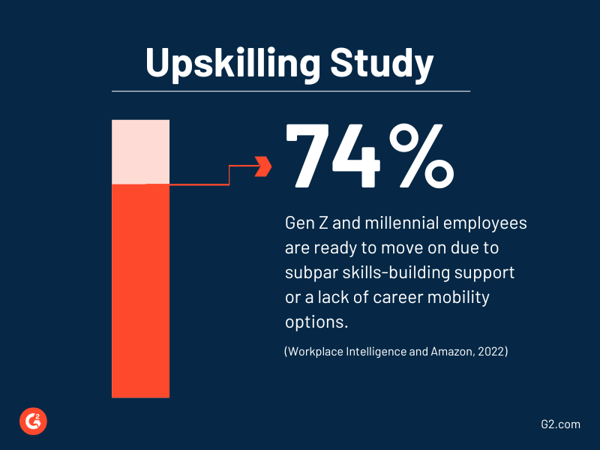
Building a skills-based organization means moving toward future-proofing businesses.
From mapping essential skills to redefining hiring practices and investing in continuous people development, all these strategies are pivotal in shaping a robust, innovative, and adaptable workforce.
Discover how identifying skills gaps and tailoring training programs can be crucial to transforming talent and elevating excellence in a workplace.
Three key strategies are essential to establishing a skills-based organization and optimizing the workforce.
The first strategy involves creating a skills map, which requires identifying workforce gaps and aligning skills with organizational objectives. This step also involves defining processes and structuring taxonomies to match job roles with essential skills.
The second strategy focuses on implementing skills-based hiring, prioritizing skills and potential over traditional experience-centric approaches. One of the primary goals is to foster a more inclusive talent acquisition process where organizations implement clear strategies to eliminate biases and revamp recruitment methods.
Lastly, it is imperative to invest in skills development by providing comprehensive training opportunities and adapting to market shifts.
To maximize future development outcomes, it's essential for all members of the organization to actively participate in reshaping our organizational paradigms to thrive in today's dynamic landscape.
Lightcast offers a visionary perspective on the new landscape of work, describing the new shift from traditional jobs to new models centered around skills.
Mark H. Hanson, VP of Strategy, Skills, & People Analytics, Lightcast, says:
"Eventually, the concept of a job could disappear altogether, with employees assigned projects fluidly based on their skills and compensation linked explicitly to skills. In this future, employees would have a powerful incentive to grow their skills and stay sharp."
In response to the evolving needs of today's workforce, new technologies in place, and the challenges faced by companies struggling with high turnover rates, the idea of a skills-led organization represents a promising solution.
Unlike traditional models that prioritize factors like tenure and experience, a skills-led approach focuses on developing and aligning skill sets with immediate business goals and broader industry trends.
This shift recognizes the dynamic nature of work and the need for organizations to adapt to their employees' evolving needs and expectations around career and personal development.
Deloitte's influential report, "The skills-based organization: A new operating model for work and the workforce," sheds light on this transformative organizational approach. It emphasizes how companies can improve their reputation and enable innovation by accurately estimating their employees’ ambitions linked to their capabilities.
Furthermore, as highlighted by Deloitte, these companies often distinguish themselves in their efforts to enhance inclusion and address diversity, equity, and inclusion (DEI) issues.
At the heart of this model is the concept of skills mapping, which serves as a foundation for building a solid skills-led organization.
By creating a detailed skills map, companies gain valuable insights into the essential competencies needed to navigate today's complex business landscape. This process allows organizations to identify existing skills within their workforce, foresee changes, and take action.
By implementing a structured approach to skills mapping, organizations can demonstrate the tangible benefits of this strategy.
In essence, the journey toward building a skills-led organization is characterized by a commitment to continuous learning, adaptation, and innovation.
By embracing the principles of skills mapping and aligning skill development with organizational objectives and industry trends, businesses can position themselves as agile, resilient entities capable of thriving amidst the uncertainties of today's dynamic business landscape.
Leadership plays a vital role in building a workplace culture that promotes continual learning and skill enhancement.
To create such a culture, leaders should prioritize learning and make it an integral part of the organizational values and objectives. They should promote learning but mainly demonstrate it through their actions by providing resources, training programs, and mentorship opportunities to support employee development.
Influential leaders set an example by showing their commitment to learning, encouraging their teams to be curious, and enhancing their skills. Doing so creates an environment where learning is valued and considered essential for growth and success. Ultimately, the guidance and influence of forward-thinking leaders can make a significant difference in fostering such a culture.
Another essential aspect of optimal leadership focused on skills development is understanding how to align staff with the right roles. In fact, skills mapping helps leaders evaluate each employee's capabilities, enabling the assignment of suitable tasks or projects and reducing errors.
Additionally, it facilitates the formation of teams with complementary skill sets, thereby enhancing productivity and efficiency.
Skills mapping also assists in identifying potential successors for critical roles within the organization. By taking a proactive approach, leaders can ensure a smooth transition when individuals need to leave the organization, maintaining continuity and stability.
In the current job market, companies are changing hiring practices to prioritize skills and unlock potential rather than experience-based approaches. This move towards skill-based hiring aims to identify candidates with the necessary competencies to excel in their roles rather than solely focusing on past job titles or tenure.
By emphasizing skill contribution, companies can build diverse and dynamic teams better equipped to meet the challenges of today's rapidly changing business landscape.
Moreover, eliminating bias in hiring is essential for fostering inclusivity and ensuring fair opportunities for all candidates. Strategies to revamp recruitment methods include using technology, involving AI, implementing skills assessments, and conducting behavioral interviews to assess candidates' abilities accurately.
Organizations can attract top talent, improve employee retention, and ultimately drive long-term success by adopting a skills-first approach to recruitment.
To achieve organizational excellence and adaptability, empowering HR for effective skill mapping and upskilling is crucial.
HR departments must be equipped with the fundamental tools and reporting solutions to navigate organizational change seamlessly. Providing practical insights for designing and implementing upskilling programs within organizations is pivotal, as it fosters employee development and enhances workforce capabilities.
Recognizing the significance of identifying skills gaps and tailoring training programs is essential to ensure targeted skill enhancement that aligns with overarching business objectives.
Additionally, showcasing successful case studies of companies with robust upskilling initiatives provides invaluable lessons and inspiration for organizations committed to cultivating a continual learning and growth culture.
One thing to remember is that HR units often lack time and struggle to follow the company’s current talent development status.
Having and maintaining a skill taxonomy will help set up long-term success. Why? Because a database of skills offers a clear, objective overview of all roles and job titles, making it easier to hire and seek the most needed skills to bridge gaps within the various departments.
Consequently, L&D units can distribute training courses and offer guidance without doubts.
It’s essential to understand that this isn’t just about bridging skills gaps and providing check-box training. It’s about supporting employees in aspirational development to reach meaningful performance goals and retain employees through structured career paths.
This shift not only transforms HR roles but also prompts stakeholders and decision makers to rethink their strategies for attracting and retaining talent, paving the way for a new era of organizational development.
Establishing comprehensive skills training and development opportunities is pivotal in cultivating a culture of continual learning and advancement within the organization.
Through accessible training programs and resources, organizations should empower their employees to enhance their skills and continually stay updated with industry trends.

Source: Workplace Intelligence
Additionally, with the prevalence of market disruptions and the evolving skills landscape, companies must leverage AI tools and technologies effectively. These tools offer the capability to identify emerging skill requirements, forecast future trends, and customize training initiatives, ensuring that employees possess the necessary skills to meet evolving market demands.
This strategy ensures that employees have the skills needed to excel in their roles and prepares them to adapt to future challenges and opportunities.
Moreover, achieving a balance between hard and soft skills in the training agenda is essential. While hard skills are indispensable for task execution, soft skills like communication, emotional intelligence, collaboration, and adaptability are equally critical for fostering innovation and driving organizational success.
Thus, investing in a holistic training agenda that encompasses developing hard and soft skills is key for nurturing a resilient and agile workforce capable of navigating today's dynamic business landscape and seizing emerging opportunities.
In exploring future trends in skills development and AI, it is clear that technological advancements are poised to revolutionize how we approach training and upskilling in the workplace.
One of the most exciting developments is integrating virtual reality (VR), augmented reality (AR), and gamification into training programs. These immersive technologies offer a hands-on learning experience that engages employees and enhances knowledge retention.
Picture employees stepping into virtual simulations to practice real-life scenarios or using AR overlays to access on-the-job guidance and instructions—these innovative approaches aim to transform traditional training methods.
AI-powered tools and platforms will be crucial in facilitating personalized learning experiences tailored to each employee's unique needs and preferences. Companies like Google and IBM already use AI to analyze employee data and deliver targeted training recommendations, resulting in more efficient and effective upskilling initiatives.
As we move forward, it's clear that embracing these future trends in skills development and AI will be key to building a workforce that's adaptable, resilient, and prepared for the challenges of tomorrow.
In talent acquisition and development, three companies stand out for their skills-driven approach.
The e-commerce giant Amazon has transformed its hiring process by prioritizing skills and potential over traditional metrics like experience.
Amazon uses a multifaceted assessment method that includes behavioral interviews, skills tests, and case studies to identify candidates with the essential skills required to excel in their roles.
Canva, the graphic design platform, has carved out a niche for itself by providing its employees with various learning resources. From online courses to in-person training sessions and mentorship programs, Canva ensures that its workforce has access to the required tools to continuously develop and enhance their skills.
Their commitment to skills-based hiring further underscores their dedication to nurturing talent from within.
Meanwhile, Sprout Social, an innovative player in the social media management space, takes a unique approach to skills assessment with its pioneering tool, Skills Canvas.
This platform enables candidates to effectively identify and showcase their skills, simplifying the hiring process and ensuring the right fit for each role.
In a landscape where talent is the driving force behind success, these companies are shining examples of the transformative power of a skills-driven approach. By focusing on skills and potential rather than conventional benchmarks, they attract top talent and nurture a workforce primed for innovation and growth.
A skills-based organizational model can generate many competitive advantages that propel businesses toward success in today's dynamic landscape.
Firstly, such a model promotes increased innovation and productivity. Studies like the one conducted by McKinsey & Company reveal that skill-centric organizations boast a 12% higher likelihood of innovation compared to their traditional counterparts.
Employees with the necessary skills to excel in their roles are more inclined to unleash their creativity and drive productivity to new heights.
Moreover, embracing a skills-based approach nurtures improved employee engagement and retention. Companies that prioritize skills development witness a surge in employee satisfaction and commitment.
According to Deloitte, a staggering 75% of employees deem skills development crucial for their career advancement, underscoring its pivotal role in fostering a motivated and loyal workforce.
Furthermore, such a model facilitates better decision-making processes. With a comprehensive understanding of their workforce's skills and capabilities, organizations can make informed decisions regarding hiring, development, and resource allocation.
Inclusive talent acquisition requires organizations to identify and eliminate biases hindering fair and equitable hiring processes.
Organizations should be aware of multiple biases that can affect their hiring processes, including implicit bias, which arises from unconscious stereotypes, and affinity bias, where hiring managers tend to favor candidates with similar backgrounds.
By actively identifying and addressing these biases in their hiring processes, organizations can create more inclusive environments where all candidates have an equal opportunity to succeed.
This may involve implementing structured interview processes, unconscious bias training for hiring managers, diverse candidate sourcing strategies, and regular hiring data reviews.
In conclusion, the transformative impact of adopting a skills-based organizational model cannot be overstated.
From driving innovation and productivity to fostering employee engagement and diversity, such an approach empowers companies to thrive in today's complex business landscape.
Learn the secret to smart, compelling video production and make your company's eLearning videos stand out.
Edited by Jigmee Bhutia
Claudia Domenici is the Content and Partner Marketing Manager at eloomi, bringing over three years of expertise in B2B marketing, impactful copywriting, and brand identity development. She is recognized for creating engaging content strategies across diverse channels and driving successful product launches.
Workforce planning and development is a hot topic in every organization. However, many still...
 by Blake Proberts
by Blake Proberts
Feeling overwhelmed by the ever-changing HR landscape?
 by Sadaf Tanzeem
by Sadaf Tanzeem
“An investment in knowledge pays the best interest.” — Benjamin Franklin
 by Courtney Moran
by Courtney Moran
Workforce planning and development is a hot topic in every organization. However, many still...
 by Blake Proberts
by Blake Proberts
Feeling overwhelmed by the ever-changing HR landscape?
 by Sadaf Tanzeem
by Sadaf Tanzeem


